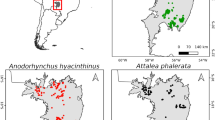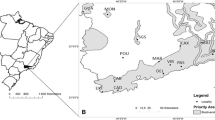Abstract
When conservation biologists formulate strategy used in decisions concerning the locations of new national parks, refuges and reserves, accurate information about species richness and spatialpatterns of species distributions can be critical. Recent research has demonstrated that spatial models and bioindicator taxa can be quite useful for determining generalized spatial patterns of unrelated taxa on a continental scale. In this research, I incorporate abiotic effects, in this case altitudinal relief, into both the mean and the covariance structures of the spatial prediction model. I use bird species data collected in the Indian subcontinent and cross-validation techniques to illustrate the degree of improvement in prediction accuracy engendered by using theabiotic factor and the modified spatial models.
Similar content being viewed by others
References
Ahmed, S. and De Marsily, G. (1987) Comparison of geostatistical methods for estimating transmissivity using data on transmissivity and specific capacity. Water Resources Research, 23, 1717-37.
Ali, S. and Ripley, S.D. (1987) Compact Book of the Birds of India, Pakistan Together with those of Bangladesh, Nepal, Bhutan and Sri Lanka. 2nd ed., Oxford University Press, Oxford, U.K.
Asli, M. and Marcotte, D. (1995) Comparison of approaches to spatial estimation in a bivariate context. Mathematical Geology, 27, 641-58.
Bogaert, P. (1996) Comparison of kriging techniques in a space-time context. Mathematical Geology, 28, 73-86.
Carroll, S.S. and Cressie, N. (1997) Spatial modeling of snow water equivalent using covariances estimated from spatial and geomorphic attributes. Journal of Hydrology, 190, 42-59.
Carroll, S.S. and Pearson, D.L. (1998) Spatial modeling of butterfly species diversity using tiger beetles as a bioindicator taxon. Ecological Applications, 8, 531-543.
Cressie, N. (1985) Fitting variogram models by weighted least squares. Journal of the International Association for Mathematical Geology, 17, 563-86.
Cressie, N. (1991) Statistics for Spatial Data, John Wiley, New York.
Cressie, N. and Hawkins, D.M. (1980) Robust estimation of the variogram, I. Journal of the International Association for Mathematical Geology, 12, 115-25.
Currie, D.J. (1991) Energy and large-scale patterns of animal and plant-species richness. American Naturalist, 137, 27-49.
Draper, N. and Smith, H. (1981) Applied Regression Analysis, John Wiley, New York.
Gotway, C.A. and Cressie, N.A.C. (1990) A spatial analysis of variance applied to soil-water infiltration. Water Resources Research, 26, 2695-703.
Gotway, C.A. and Hartford, A.H. (1996) Geostatistical methods for incorporating auxiliary information in the prediction of spatial variables. Journal of Agricultural, Biological, and Environmental Statistics, 1, 17-39.
Haas, T.C. (1996) Multivariate spatial prediction in the presence of non-linear trend and covariance non-stationarity. Environmetrics, 7, 145-65.
Hawkins, D.M. and Cressie, N. (1984) Robust kriging–a proposal. Journal of the International Association for Mathematical Geology, 16, 3-18.
Holdridge, L.R., Grenke, W.C., Hatheway, W.H., Laing, T. and Tosi, Jr., J.A. (1971) Forest Environments in Tropical Life Zones: A Pilot Study, Pergamon Press, New York.
Journel, A.G. and Huijbregts, C.J. (1978) Mining Geostatistics, Academic Press, London.
Judge, G.G., Griffiths, W.E., Hill, R.C., Lütkepohl, H. and Lee, T-C. (1985) The Theory and Practice of Econometrics. John Wiley, New York.
Kemp, W.P., Kalaris, T.M. and Quimby, W.F. (1989) Rangeland grasshopper (Orthoptera: Acrididae) spatial variability: macroscale population assessment. Journal of Economic Entomology, 82, 1270-76.
Kremen, C. (1994) Biological inventory using target taxa: a case study of the butterflies of Madagascar. Ecological Applications, 4, 407-22.
Kuliopulos, H. (1990) Amazonian biodiversity. Science, 248, 1305.
Landres, P.B., Verner, J. and Thomas, J.W. (1988) Ecological uses of vertebrate indicator species: a critique. Conservation Biology, 2, 316-28.
MacArthur, R.H., Recher, H. and Cody, M. (1966) On the relation between habitat selection and species diversity. American Naturalist, 100, 319-32.
Matheron, G. (1963) Principles of geostatistics. Economic Geology, 58, 1246-66.
Myers, N. (1990) The biodiversity challenge: extended hot spot analysis. The Environmentalist, 10, 243-56.
Noss, R.F. (1990) Indicators for monitoring biodiversity: a hierarchical approach. Conservation Biology, 4, 355-64.
Pearson, D.L. (1994) Selecting indicator taxa for the quantitative assessment of biodiversity. Philosophical Transactions Royal Society of London B, 345, 75-79.
Pearson, D.L. and Carroll, S.S. (1998) Global patterns of species richness: spatial models for conservation planning using bioindicator and precipitation data. Conservation Biology, 12, 809-821.
Pearson, D.L. and Cassola, F. (1992) World-wide species richness patterns of tiger beetles (Coleoptera: Cicindelidae): Indicator taxon for biodiversity and conservation studies. Conservation Biology, 6, 376-91.
Pimm, S.L. and Gittleman, J.L. (1992) Biological diversity: where is it? Science, 255, 940.
Prance, G.T. (1995) A comparison of the efficacy of higher taxa and species numbers in the assessment of biodiversity in the Neotropics. In Biodiversity: Measurement and Estimation, D.L. Hawksworth, (ed), Chapman and Hall, London, England. pp. 89-99.
Rao, C.R. (1973) Linear Statistical Inference and Its Applications, John Wiley, New York.
Robertson, G.P. (1987) Geostatistics in ecology: interpolation with known variance. Ecology, 68, 744-48.
Rodriguez-Iturbe, I. and Mejia, J.M. (1974) The design of rainfall networks in time and space. Water Resources Research, 10, 713-28.
Schmidt, P. (1976) Econometrics, Marcel Dekker, New York.
Searle, S.R. (1971) Linear Models, John Wiley, New York.
Stein, A. and Corsten, L.C.A. (1991) Universal kriging and cokriging as a regression procedure. Biometrics, 47, 575-87.
Stone, M. (1974) Cross-validation choice and assessment of statistical predictions. Journal of the Royal Statistical Society B, 36, 111-147.
Wackernagel, H. (1995) Multivariate Geostatistics, Springer, Berlin.
Author information
Authors and Affiliations
Rights and permissions
About this article
Cite this article
Carroll, S.S. Modelling abiotic indicators when obtaining spatial predictions of species richness. Environmental and Ecological Statistics 5, 257–276 (1998). https://doi.org/10.1023/A:1009625520502
Issue Date:
DOI: https://doi.org/10.1023/A:1009625520502




